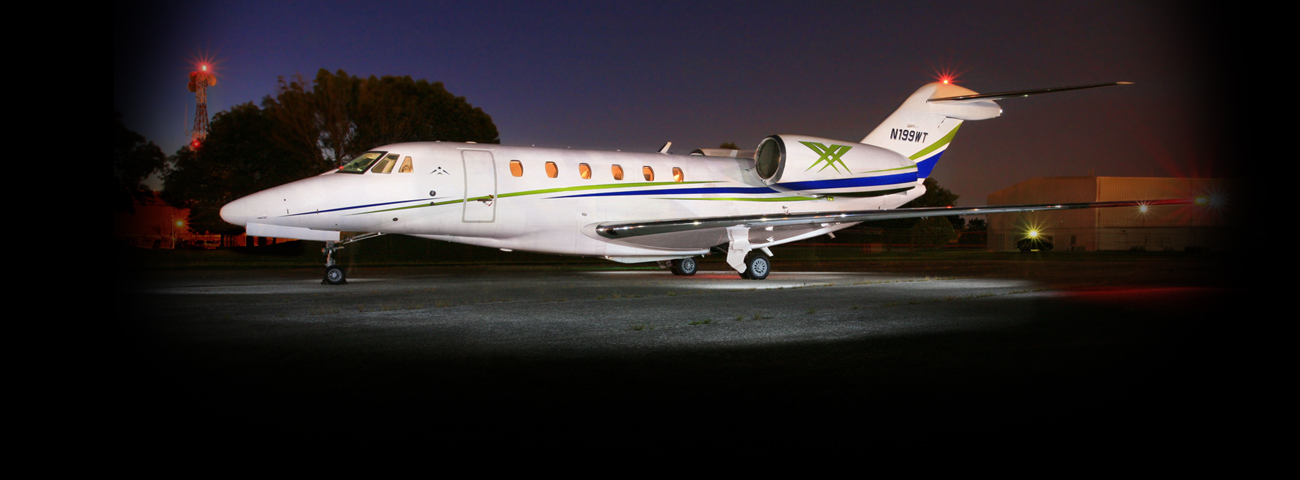1996 - Present Citation X


The Cessna Citation X is a long range medium business jet aircraft. The X is the fastest operative civilian jet with a top speed of Mach 0.92 (703 mph, 1131 km/h). This also made it the fastest business jet in history. The Citation X is powered by two Rolls-Royce turbofan engines and is built by the Cessna Aircraft Company in Wichita, Kansas. The Citation brand of business jets encompasses six distinct "families" of aircraft. Although based on the earlier Citation III, VI and VII models the Citation X is a significantly different airplane. It utilizes a totally new wing design, engines, and features a glass cockpit. Despite Cessna's long history of building business jets and the number of aircraft in the Citation family, the Citation X was in many ways a completely new aircraft. The wing, tail, tail cone, gear, and systems are designed from scratch and not based on pre-existing aircraft. The Citation X is also the first aircraft from Cessna to use a Rolls-Royce engine and fully-integrated avionics. Although the Citation X may look similar to its predecessors, it is almost entirely composed of new parts. Part commonality is limited to some cockpit controls, the windshield, and the tail light bulb. The pressure bulkhead is also similar to previous designs. The Citation X has the same fuselage diameter as the Citations VI and VII; however, the wing attachment to the fuselage is different from the attachment in any previous Citation. The aircraft incorporates a number of innovative design features. One attribute that is often first noticed is the large diameter of the engine intakes. This feature, related to the high bypass ratio turbofan, reduces the noise from the engines and improves fuel efficiency. Another obvious characteristic is the highly swept wing with a supercritical airfoil, used in order to increase the critical Mach number and therefore the top speed. The Citation X has 37 degrees of sweepback at the quarter chord, more than any other business jet and, among civil aircraft, second only to the Boeing 747's 37.5 degrees. The horizontal and vertical stabilizers are also highly swept and are arranged in a T-tail configuration.

Aircraft Information
| Year: |
1996 - Present |
| Make: |
Citation |
| Model: |
X |
| Active Fleet: |
318 - For Sale/Lease: 22
|
| Average Asking Price - February 2014: |
$5,970,000 |
| Range: |
2,890 - 3,125 nm |
| Contact Number: |
1-847-726-5000 |
| Current Market Price / Availability: |
REQUEST MARKET UPDATE REPORT |
General Performance & Specifications
| Cabin Height: |
5.70 Feet |
| Cabin Width: |
5.50 Feet |
| Cabin Length: |
23.92 Feet |
| Baggage Volume Internal: |
|
| Baggage Volume External: |
82.0 Cubic Feet |
| Seats Executive: |
*2/8 |
| Max. Take-Off Weight: |
36,100 lbs. |
| Max. Landing Weight: |
31,800 lbs. |
| Maximum Payload: |
2,375 lbs. |
| Balance Field Length: |
5,480 Feet |
| Landing Distance: |
4,694 Feet |
| Rate of Climb - All Engines: |
3,650 Feet / Minute |
| Rate of Climb - One Engine Out: |
1,120 Feet / Minute |
| Normal Cruise Speed: |
525 ktas |
| Max. Cruise Speed: |
525 ktas |
| Service Ceiling Max. Weight: |
43,000 Feet |
| Number of Engines: |
2 |
| Engine Manufacturer: |
Rolls Royce |
| Engine Model: |
AE 307C1 |
Description
The Cessna Citation X is a long range medium business jet aircraft. The X is the fastest operative civilian jet with a top speed of Mach 0.92 (703 mph, 1131 km/h). This also made it the fastest business jet in history. The Citation X is powered by two Rolls-Royce turbofan engines and is built by the Cessna Aircraft Company in Wichita, Kansas. The Citation brand of business jets encompasses six distinct "families" of aircraft. Although based on the earlier Citation III, VI and VII models the Citation X is a significantly different airplane. It utilizes a totally new wing design, engines, and features a glass cockpit.
Despite Cessna's long history of building business jets and the number of aircraft in the Citation family, the Citation X was in many ways a completely new aircraft. The wing, tail, tail cone, gear, and systems are designed from scratch and not based on pre-existing aircraft. The Citation X is also the first aircraft from Cessna to use a Rolls-Royce engine and fully-integrated avionics. Although the Citation X may look similar to its predecessors, it is almost entirely composed of new parts. Part commonality is limited to some cockpit controls, the windshield, and the tail light bulb. The pressure bulkhead is also similar to previous designs. The Citation X has the same fuselage diameter as the Citations VI and VII; however, the wing attachment to the fuselage is different from the attachment in any previous Citation.
The aircraft incorporates a number of innovative design features. One attribute that is often first noticed is the large diameter of the engine intakes. This feature, related to the high bypass ratio turbofan, reduces the noise from the engines and improves fuel efficiency. Another obvious characteristic is the highly swept wing with a supercritical airfoil, used in order to increase the critical Mach number and therefore the top speed. The Citation X has 37 degrees of sweepback at the quarter chord, more than any other business jet and, among civil aircraft, second only to the Boeing 747's 37.5 degrees. The horizontal and vertical stabilizers are also highly swept and are arranged in a T-tail configuration.
















